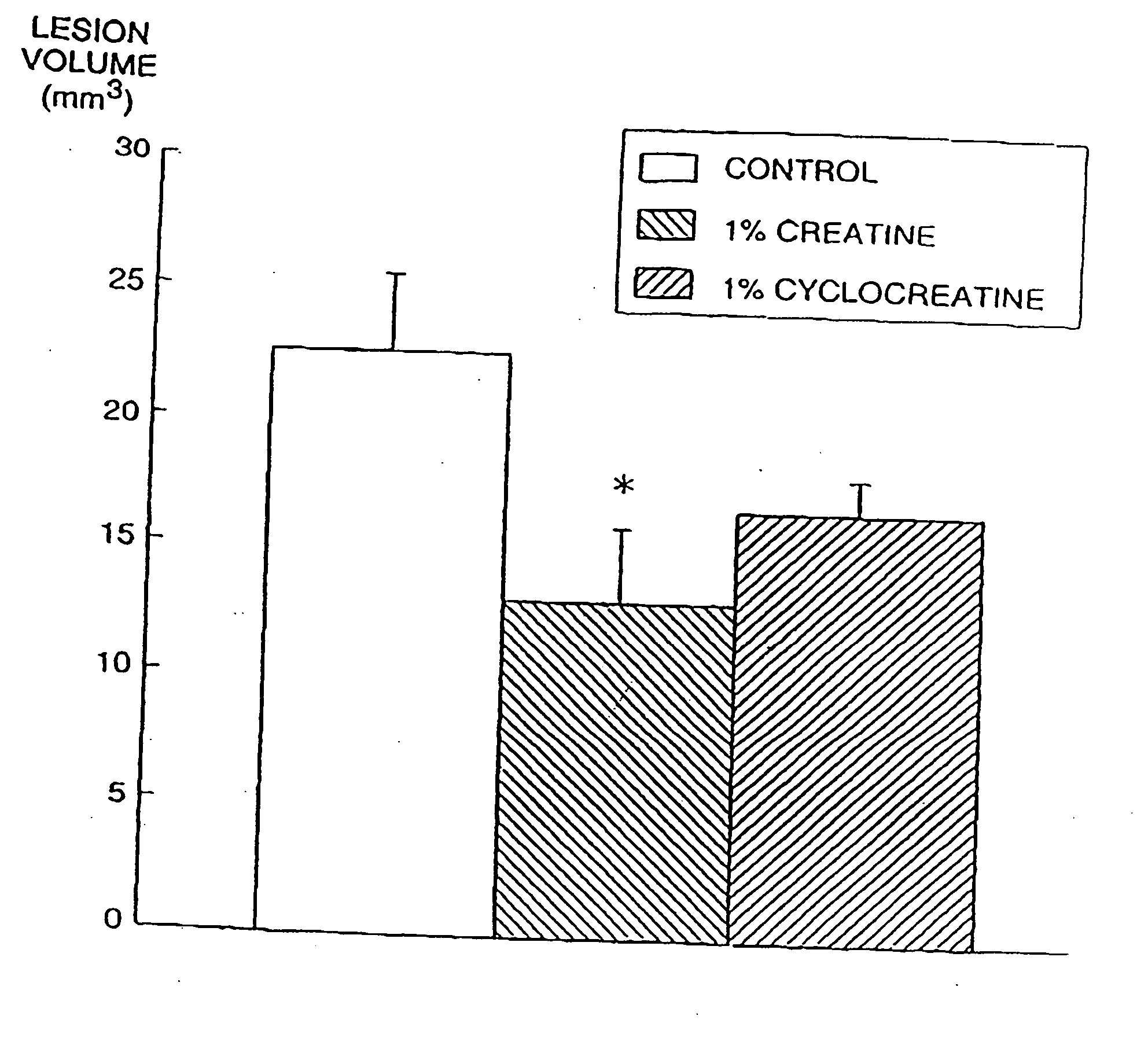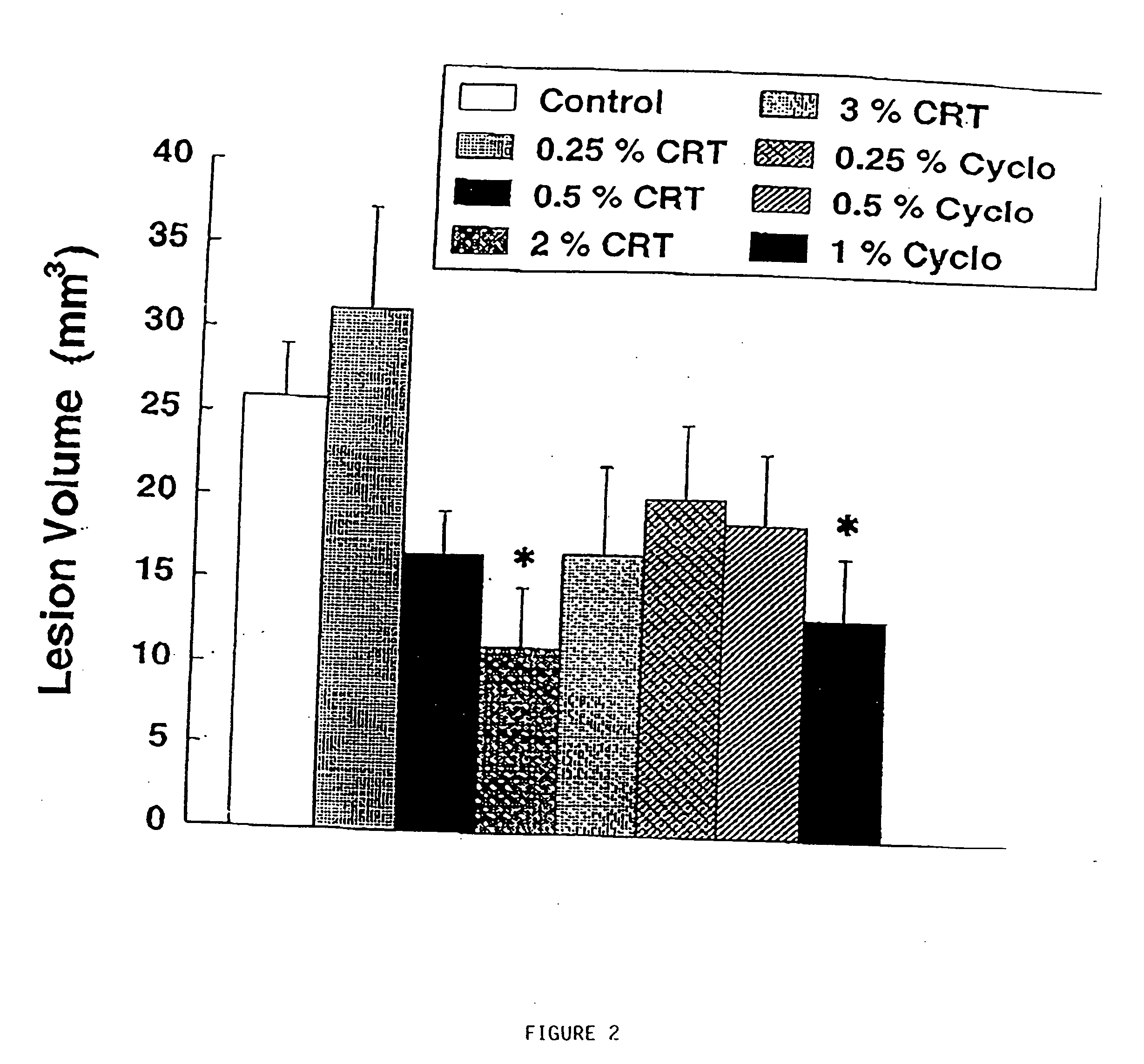Compositions containing a combination of a creatine compound and a second agent
a technology of creatine compound and compound, which is applied in the field of compositions containing a combination of a creatine compound and a second agent, can solve the problems of reducing the function of the nervous system, and achieve the effect of modulating a nervous system diseas
- Summary
- Abstract
- Description
- Claims
- Application Information
AI Technical Summary
Benefits of technology
Problems solved by technology
Method used
Image
Examples
example 1
Models for Huntington's Disease: Malonate and 3-Nitropropionic Acid
[0229] There is substantial evidence that energy production may play a role in the pathogenesis of neurodegenerative diseases (Beal et al., Ann. Neurol. 31:119-130 (1992)). Impaired energy production may lead to activation of excitatory amino acid receptors, increases in intracellular calcium and the generation of free radicals (Beal et al., Ann. Neurol. 38:357-366 (1995)). In Huntington's Disease (HD) there is reduced mitochondrial complex II-III activity in post mortem tissue and increased cerebral lactate concentrations in vivo (Browne et al., Ann. Neurol., in press, (1997); Gu et al., Ann. Neurol. 39:385-389 (1996); Jenkins et al., Neurology 43 :2689-2695 (1993)).
[0230] Animal models of Huntington's disease involve defects in energy production. Malonate and 3-nitropropionic acid (3-NP) are, respectively, reversible and irreversible inhibitors of complex II (succinate dehydrogenase) which produce striatal lesion...
example 2
MPTP as a Model for Parkinson's Disease
[0238] MPTP, or 1-methyl-4-phenyl-1,2,3,6-tetrahydropyridine is a neurotoxin which produces a Parkinsonian syndrome in both man and experimental animals. The initial report was by a chemist who was synthesizing and self injecting an opiate analogue. He inadvertently synthesized MPTP and developed profound Parkinsonism. Subsequent pathologic studies showed severe degeneration in the pars compacta of the substantia nigra. A large outbreak subsequently occurred in California. These patients developed typical symptoms of Parkinsonism. They also had positron emission tomography done which showed a marked loss of dopaminergic innervation of the striatum.
[0239] Studies of the mechanism of MPTP neurotoxicity show that it involves the generation of a major metabolite, MPP+. This metabolite is formed by the activity of monoamine oxidase on MPTP. Inhibitors of monoamine oxidase block the neurotoxicity of MPTP in both mice and primates. The specificity o...
example 3
Effect of Dietary Creatine in a Mouse Model for ALS
[0244] Motor neuron degeneration was generated in mice that express a human Cu, Zn superoxide dismutase mutation. Gurney et al., Science, vol. 264, pp 1772-1775 (1994) These FALS mice develop a syndrome which mimics the symptoms of familial amyotropic lateral sclerosis (FALS). Gradual loss of motor function becomes apparent, and typically the mice do not survive beyond 140 days.
[0245] FALS mice were divided into control and test groups. At approximately 80 days (between 70 and 90 days) after birth, the test groups (containing 5 mice per group) were changed over from a standard diet to a diet containing 1% creatine. The control group (containing 6 mice per group) were fed the standard diet.
Behavioral Testing-Rotorod
[0246] Mice were given two days to become aquatinted with the rotorod apparatus before testing began. Testing began with the animals trying to stay on a rod that was rotating at 1 rpm. The speed was then increased by ...
PUM
| Property | Measurement | Unit |
|---|---|---|
| pH | aaaaa | aaaaa |
| shape | aaaaa | aaaaa |
| energy | aaaaa | aaaaa |
Abstract
Description
Claims
Application Information
 Login to View More
Login to View More - R&D
- Intellectual Property
- Life Sciences
- Materials
- Tech Scout
- Unparalleled Data Quality
- Higher Quality Content
- 60% Fewer Hallucinations
Browse by: Latest US Patents, China's latest patents, Technical Efficacy Thesaurus, Application Domain, Technology Topic, Popular Technical Reports.
© 2025 PatSnap. All rights reserved.Legal|Privacy policy|Modern Slavery Act Transparency Statement|Sitemap|About US| Contact US: help@patsnap.com



